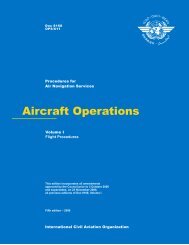Operation of Aircraft
Annex 6, Part I
Annex 6, Part I
- No tags were found...
Create successful ePaper yourself
Turn your PDF publications into a flip-book with our unique Google optimized e-Paper software.
Annex 6 — <strong>Operation</strong> <strong>of</strong> <strong>Aircraft</strong><br />
e) the operation <strong>of</strong> stopping the propeller is not initiated<br />
until the aeroplane has cleared a point 15.2 m (50 ft)<br />
above the take-<strong>of</strong>f surface.<br />
2.6.3.2 Suitable methods are provided and employed to<br />
take into account, and to correct for, any vertical gradient <strong>of</strong><br />
wind velocity which may exist during the take-<strong>of</strong>f.<br />
2.7 Take-<strong>of</strong>f distance required<br />
The take-<strong>of</strong>f distance required is the horizontal distance along<br />
the take-<strong>of</strong>f flight path from the start <strong>of</strong> the take-<strong>of</strong>f to a point<br />
where the aeroplane attains a height <strong>of</strong> 15.2 m (50 ft) above<br />
the take-<strong>of</strong>f surface.<br />
2.8 Temperature accountability<br />
Operating correction factors for take-<strong>of</strong>f mass and take-<strong>of</strong>f<br />
distance are determined to account for temperature above and<br />
below those <strong>of</strong> the Standard Atmosphere. These factors are<br />
obtained as follows:<br />
a) For any specific aeroplane type the average full<br />
temperature accountability is computed for the range <strong>of</strong><br />
mass and altitudes above sea level, and for ambient<br />
temperatures expected in operation. Account is taken <strong>of</strong><br />
the temperature effect both on the aerodynamic<br />
characteristics <strong>of</strong> the aeroplane and on the engine power.<br />
The full temperature accountability is expressed per<br />
degree <strong>of</strong> temperature in terms <strong>of</strong> a mass correction, a<br />
take-<strong>of</strong>f distance correction and a change, if any, in the<br />
position <strong>of</strong> the critical point.<br />
b) Where 2.6.2 is used to determine the take-<strong>of</strong>f path, the<br />
operating correction factors for the aeroplane mass and<br />
take-<strong>of</strong>f distance are at least one half <strong>of</strong> the full<br />
accountability values. Where 2.6.3 is used to determine<br />
the take-<strong>of</strong>f path, the operating correction factors for the<br />
aeroplane mass and take-<strong>of</strong>f distance are equal to the<br />
full accountability values. With both methods, the<br />
position <strong>of</strong> the critical point is further corrected by the<br />
average amount necessary to assure that the aeroplane<br />
can stop within the runway length at the ambient<br />
temperature, except that the speed at the critical point is<br />
not less than a minimum at which the aeroplane can be<br />
controlled with the critical power-unit inoperative.<br />
3. Landing<br />
3.1 General<br />
The landing performance is determined:<br />
a) for the following conditions:<br />
1) sea level;<br />
Part I<br />
2) aeroplane mass equal to the maximum landing mass<br />
at sea level;<br />
3) level, smooth, dry and hard landing surfaces (landplanes);<br />
4) smooth water <strong>of</strong> declared density (seaplanes);<br />
b) over selected ranges <strong>of</strong> the following variables:<br />
1) atmospheric conditions, namely: altitude and also<br />
pressure-altitude and temperature;<br />
2) aeroplane mass;<br />
3) steady wind velocity parallel to the direction <strong>of</strong><br />
landing;<br />
4) uniform landing-surface slope (landplanes);<br />
5) type <strong>of</strong> landing surface (landplanes);<br />
6) water surface condition (seaplanes);<br />
7) density <strong>of</strong> water (seaplanes);<br />
8) strength <strong>of</strong> current (seaplanes).<br />
3.2 Landing distance<br />
3.2.1 The landing distance is the horizontal distance<br />
between that point on the landing surface at which the aeroplane<br />
is brought to a complete stop or, for seaplanes, to a<br />
speed <strong>of</strong> approximately 6 km/h (3 kt) and that point on the<br />
landing surface which the aeroplane cleared by 15.2 m (50 ft).<br />
3.3 Landing technique<br />
3.3.1 In determining the landing distance:<br />
a) immediately before reaching the 15.2 m (50 ft) height, a<br />
steady approach is maintained, landing gear fully<br />
extended, with an airspeed <strong>of</strong> not less than 1.3V S 0 ;<br />
b) the nose <strong>of</strong> the aeroplane is not depressed in flight nor<br />
the forward thrust increased by application <strong>of</strong> engine<br />
power after reaching the 15.2 m (50 ft) height;<br />
c) the wing flap control is set in the landing position, and<br />
remains constant during the final approach, flare out and<br />
touch down, and on the landing surface at air speeds<br />
above 0.9V S 0<br />
. When the aeroplane is on the landing<br />
surface and the airspeed has fallen to less than 0.9V S 0 ,<br />
change <strong>of</strong> the wing-flap-control setting is permitted;<br />
1/11/01 ATT C-8












